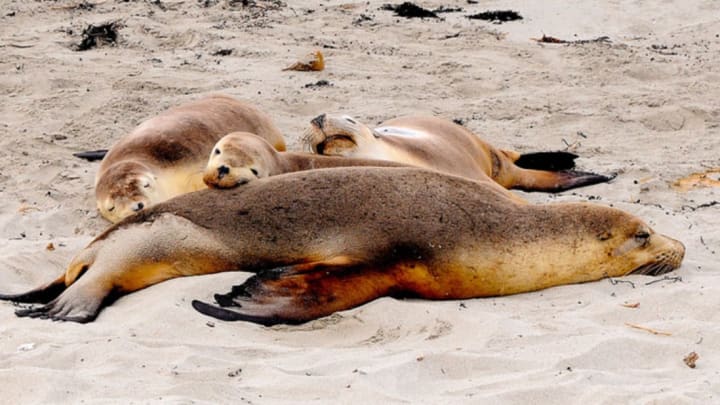When British explorers happened upon Kangaroo Island—a Puerto Rico-sized drop of land south of what today is the city of Adelaide—the animals took them by surprise. Unlike the wild ‘roos of the mainland, who knew to keep their distance, these creatures were utterly tame and approachable (so much so that the arriving crew reportedly slaughtered 31 for a giant kangaroo stew—gotta love those colonial instincts). The reason the animals were unaccustomed to humans (and tragically unfamiliar with their bad habits) was because no humans lived there. Aboriginals had once inhabited the island, but they’d abandoned it at least 2000 years prior, for reasons unknown.
After a couple of centuries of life alongside human settlers, the animals here are understandably a little more wary—but the humans, for their part, have gotten a lot more respectful. Which means that today, this one of the most incredible places to get up close and personal with some very interesting creatures out in the wild. The best way to meet them is to tour with a local company like Exceptional Kangaroo Island. Experienced guides are familiar with the animals and their habitats—so they can probably find you a tricky-to-spot echidna and point out where a koala is likely to be hiding in the crook of a tree—but they also ensure that you won’t bother the animals in the process. (And in lieu of kangaroo stew, they serve fantastic lunches that highlight the local produce.)
1. Kangaroos Kangaroos Kangaroos!

KI has it’s own subspecies of kangaroo (aptly called the Kangaroo Island, or Sooty, kangaroo). They’re shorter and stockier than their close relatives, the Western Gray, and chocolate brown in color. Like all ‘roos, they can hop very swiftly using both sets of paws and their tail—hopping is a highly efficient method of locomotion, because it “recycles” energy, like bouncing on a pogo stick. Tour companies have special access to areas of the national parks that are closed to the public, where you can see wild kangaroo populations which have been carefully acclimated to respectful visits from humans up close.
2. Cape Barren Geese

Fifty years ago, the Cape Barren goose was about to go extinct—but thanks to rehabilitation projects their population is healthy again. And yet, this light gray goose—which has a striking bright yellow bill—is one of the rarest in the world, making its home primarily along Australia’s southern coast.
3. Echidnas

They look something like a porcupine mixed with an anteater but aren’t related to either—the echidna is a monotreme, or egg-laying mammal, the only surviving relative of the platypus. There are lots of weird things about this creature, but one of the weirdest is that they don’t have a permanent pouch to stash their eggs in—they create a temporary pouch by contracting their abdominal muscles. (Both males and females can do it, so determining gender is difficult!) KI has its own subspecies—T. a. multiaculeatus—which basically means “fast tongue, very spiny!” They have a 9-inch tongue that can flick in and out 100 times in a minute, scooping up insects and larvae.
4. Black Swans

Black Swans live across the southern regions of Australia, moving nomadically between salt and freshwater wetlands. Preferring areas where eating and nesting materials are plentiful, they can also be seen in the spring in flooded pastures, like this one.
5. Sheep

Wool export has long been an integral part of the local economy; there are 400,000 sheep on the island today. This flock lives at the Stranraer Homestead, a functioning sheep station and utterly serene bed and breakfast, where lots of delicious sheep-derived haloumi cheese finds its way into the homecooked meals.
6. New Zealand Fur Seals

Despite its name, the New Zealand fur seal is a native of southern Australia. At a stunning rock formation called Admirals Arch in Flinders Chase National Park, you can find hundreds of them resting between fishing trips.
7. Australian Sea Lions
Found only on the south and west coasts of Australia, the Australian sea lion is recovering from threatened status. Females will spend up to three days swimming out to sea and feeding before returning to the beach where their pups await feeding time. Then they catch up on their rest!
8. Australian Pelican

The Australian Pelican is a medium-sized pelican, but it boasts the largest bill of any bird—the longest on record was 20 inches.
9. Tammar wallabies
The smallest of the wallabies, the rabbit-sized gray tammar can drink sea water!
10. Ligurian Bees

In the 1880s, Kangaroo Island settlers imported a dozen hives of of honey bees from Liguria, in northern Italy, to help with crop pollination and honey production. The forward-thinking beekeepers at the time had the foresight to have KI declared a bee sanctuary—limiting the import of other bee varieties—which today makes it the home of one of the only pure strains of bees anywhere in the world.
11. Koalas, of course!

The problem for koalas has never been underpopulation—in fact, the opposite has threatened this introduced species' survival on the island. Overpopulation once meant that a sadly common sight was a starving koala in a stripped-bare tree. In recent years, sterilization programs have helped get populations back to sustainable levels, so this is now a good place to spot a (well-fed) one in the wild.
All images courtesy of Jessanne Collins.
